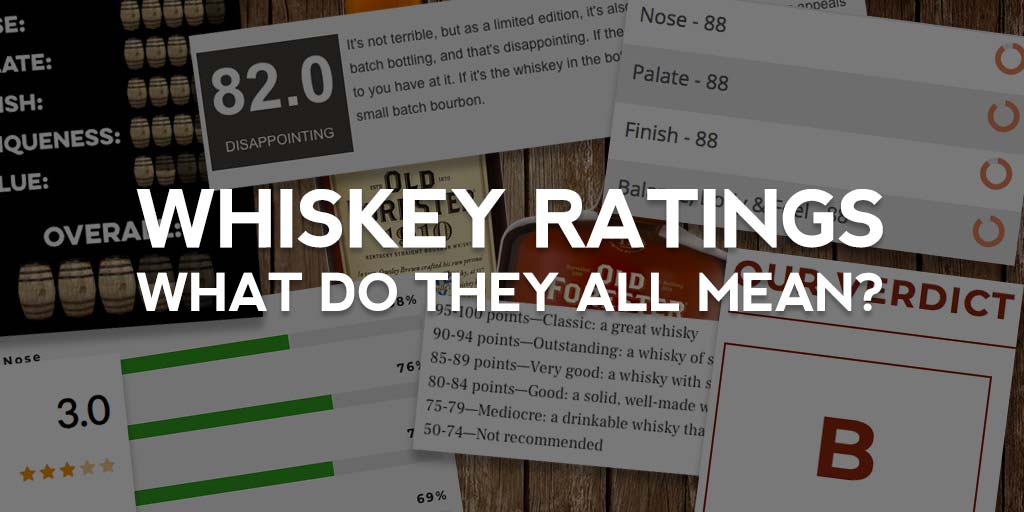Ratings, Ratings, Ratings! But what do they all mean?
Let’s face it, there are a lot of reviewers out there writing for websites, magazines and books. There are several commonalities: They’ll tell you a bit about the history or backstory, they’ll talk about mashbills, they’ll describe aromas, tasting notes and finishes.

Let’s face it, there are a lot of reviewers out there writing for websites, magazines and books. There are several commonalities: They’ll tell you a bit about the history or backstory, they’ll talk about mashbills, they’ll describe aromas, tasting notes and finishes. Some will even mention prices and where you can pick up bottles (we do that at Bourbon & Banter, but we’re cool like that). The crux, however, is the recommendation and rating.
There can be great misunderstanding and confusion as it pertains to ratings. When I write reviews, occasionally folks will comment and ask why I don’t do a rating in their preferred manner or using a more “classical” method. Some want a scale of one to five (along with cute icons like Glencairn glasses, thumbs, etc.). Others request a scale of one to ten. And, for some, they want a score of one to 100. Then, there’s the 50 to 100, such as those done by Whisky Advocate.
Of course, none begin to touch the bronze, silver, gold and double-gold ratings that you’ll find at tasting events.
But, what do they all mean? In my opinion, not a lot, and all of them leave plenty of room for interpretation. One of the great misconceptions is the award method. At most shows, everyone gets at least a bronze. That’s right! If you’ve paid your entry fee, you’re almost guaranteed to get a participation trophy (bronze). That bronze also doesn’t say much about a whiskey, either. It could be drinkable to decent, but not decent enough to get to the next level, silver. And, silver could be anywhere from the same scale (drinkable to decent). Gold is where it is at, and even then, not all golds are created equal. Then there’s that double-gold. Double-gold can be great, but not as great as Best in Category or Best in Show, which are also equally meaningless because if everything at the show is mediocre, then Best in Show is the best of the mediocre.
Next are the one-in-five or one-in-ten rankings. You’d think these would be simple to understand, but they’re not. Sure, one is pretty much horrible and, depending on the scale, five or ten is stupendous. If, on a five-point scale, a three is average, is that average decent, is that average good, or is that average, well, average? The ten-point scale leaves more room for interpretation but still doesn’t say a whole lot in the end. Do I want to buy a seven? Is there a huge difference between a seven and eight, or an eight and nine? How often is a ten given out?
Many folks enjoy the x to 100 scale ratings. Personally, I get the scale if it starts with one. But, why start it at 50, 60, or some other arbitrary number of points? To me, this is like taking the SAT: you automatically get 400 points just for writing your name. Unless the point is to not hurt anyone’s feelings by saying You suck, it just doesn’t make sense. If I use the Whisky Advocate scale, their ratings aren’t evenly measured. There’s a five-point difference between each of the categories, until, of course, you hit the bottom. The “Not Recommended” category has a 25-point spread. Is a 94-point whiskey really worse than a 95 (Outstanding versus Classic)?
When it comes to ratings, I pefer simplicity. I won’t pretend I formulated the Bourbon & Banter review/rating model, but I adopted it immediately once I saw it. I write reviews that people can both understand and relate. I don’t use fancy, esoteric descriptors that no one but the reviewer comprehends, such as lilac from grandma’s attic or simply beautiful marzipan. The Bourbon & Banter scale is very easy to understand: Bottle (buy it), Bar (try it) or Bust (leave it). It doesn’t compare apples to oranges or even whiskeys to whiskeys. It is a simple recommendation that makes perfect sense.
